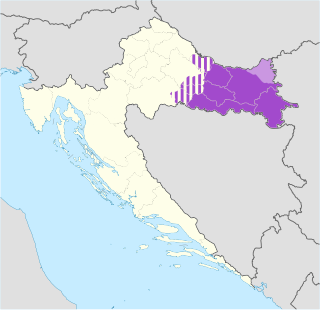
Slavonia is, with Dalmatia, Croatia proper, and Istria, one of the four historical regions of Croatia. Located in the Pannonian Plain and taking up the east of the country, it roughly corresponds with five Croatian counties: Brod-Posavina, Osijek-Baranja, Požega-Slavonia, Virovitica-Podravina, and Vukovar-Syrmia, although the territory of the counties includes Baranya, and the definition of the western extent of Slavonia as a region varies. The counties cover 12,556 square kilometres or 22.2% of Croatia, inhabited by 806,192—18.8% of Croatia's population. The largest city in the region is Osijek, followed by Slavonski Brod and Vinkovci.

Našice is a town in eastern Croatia, located on the northern slopes of the Krndija mountain in eastern Slavonia, 51 km southwest of regional hub Osijek. Administratively it belongs to Osijek-Baranja County.

Vukovar-Srijem County, Vukovar-Sirmium County or Vukovar-Syrmia County, named after the eponymous town of Vukovar and the region of Syrmia, is the easternmost Croatian county. It includes the eastern parts of the region of Slavonia and the western parts of the region of Syrmia, as well as the lower Sava river basin, Posavina and Danube river basin Podunavlje. Due to the overlapping definitions of geographic regions, division on Slavonia and Syrmia approximately divides the county vertically into north-west and south-east half, while division on Posavina and Podunavlje divides it horizontally on north-east and south-west half.

Osijek-Baranja County is a county in Croatia, located in northeastern Slavonia and Baranja which is defined part of the Pannonian Plain. Its center is Osijek. Other towns include Đakovo, Našice, Valpovo, Belišće, and Beli Manastir.
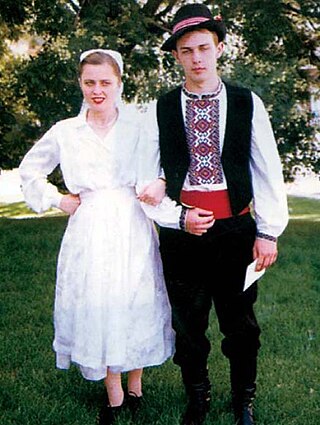
Pannonian Rusyns, also known as Pannonian Rusnaks, and formerly known as Yugoslav Rusyns, are ethnic Rusyns from the southern regions of the Pannonian Plain. Their communities are located mainly in Vojvodina, Serbia, and Slavonia, Croatia. In both of those countries, they are officially recognized as a national minority, and have several minority institutions and organizations.
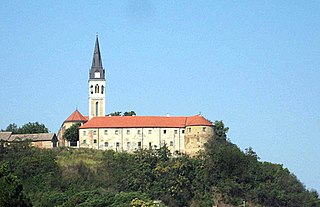
Ilok is the easternmost town in Croatia forming a geographic salient surrounded by Vojvodina. Located in the Syrmia region, it lies on the Fruška Gora hill overlooking the Danube river, which forms the border with the Bačka region of Serbia. The town is home to a Franciscan monastery and Ilok Castle, which is a popular day trip for domestic and cross-border tourists.

Czechs are one of the recognised minorities of Croatia. According to the census of 2011 there were 9,641 Czechs in Croatia, comprising 0.22% of total population.

Orahovica is a town in Slavonia, Croatia. It is situated on the slopes of the mountain Papuk and positioned on the state road D2 Varaždin-Koprivnica-Našice-Osijek.

Vrbanja is a village and a municipality in Croatia.
The Montenegrins of Croatia are a national minority in the republic. According to the 2021 census, there are 3,127 ethnic Montenegrins in Croatia. The highest number of Montenegrins in Croatia is in the Croatian capital Zagreb.
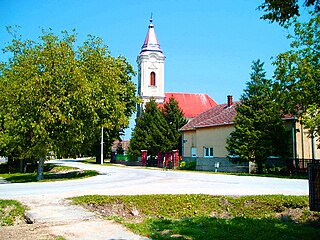
Soljani are a village in Cvelferija in the southernmost part of Vukovar-Syrmia County. From the 2011 census the village had a population of 1241 inhabitants.
Punitovci is a municipality in Osijek-Baranja County, Croatia. There are a total of 1,803 inhabitants.
In Croatia, there are over 2,900 people who consider themselves German, most of these Danube Swabians. Germans are officially recognized as an autochthonous national minority, and as such, they elect a special representative to the Croatian Parliament, shared with members of eleven other national minorities. They are mainly concentrated in the area around Osijek in eastern Slavonia.

There have been Romani people in Croatia for more than 600 years and they are concentrated mostly in the northern regions of the country.

Hungarians are a recognized ethnic minority in Croatia. According to the 2011 census there are 14,048 people of Hungarian ethnicity living in Croatia. Around two thirds of them (8,249) live in Osijek-Baranja County in eastern Croatia, especially in the Croatian part of the Baranya region which borders Hungary to the north. There are also small Hungarian communities in other parts of the country, including areas in Bjelovar-Bilogora County in central Croatia where 881 people identify themselves as Hungarian.

Bosniaks of Croatia are one of the ethnic minorities of the Republic of Croatia. According to the 2021 Croatian census, there were 24,131 Bosniaks, or 0.62% of the total population, making them the third largest ethnic group in the country after Croats and Serbs.
Slovenes of Croatia are one of 22 national minorities in Croatia. According to 2011 census, there were 10,517 Slovenes in Croatia, with majority living in only three counties Istria County, Primorje-Gorski Kotar County and consolidated city-county Zagreb.
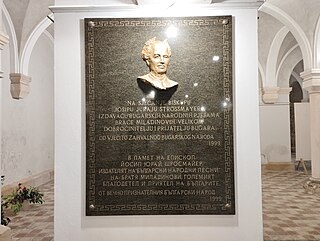
Bulgarians in Croatia are one of 22 national minorities in Croatia. According to the last census from 2011, there were 872 Bulgarians living in Croatia, from which most of them lived in Zagreb.
The Albanians of Croatia are people of full or partial Albanian ancestry and heritage who are an ethnic minority in Croatia.

The Constitution of Croatia in its preamble defines Croatia as a nation state of ethnic Croats, a country of traditionally present communities that the constitution recognizes as national minorities and a country of all its citizens. National minorities explicitly enumerated and recognized in the Constitution are Serbs, Czechs, Slovaks, Italians, Hungarians, Jews, Germans, Austrians, Ukrainians, Rusyns, Bosniaks, Slovenes, Montenegrins, Macedonians, Russians, Bulgarians, Poles, Romani, Romanians, Istro-Romanians ("Vlachs"), Turks and Albanians. Article 12 of the constitution states that the official language in Croatia is Croatian, but also states that in some local governments another language and Cyrillic or some other script can be introduced in official use.
















